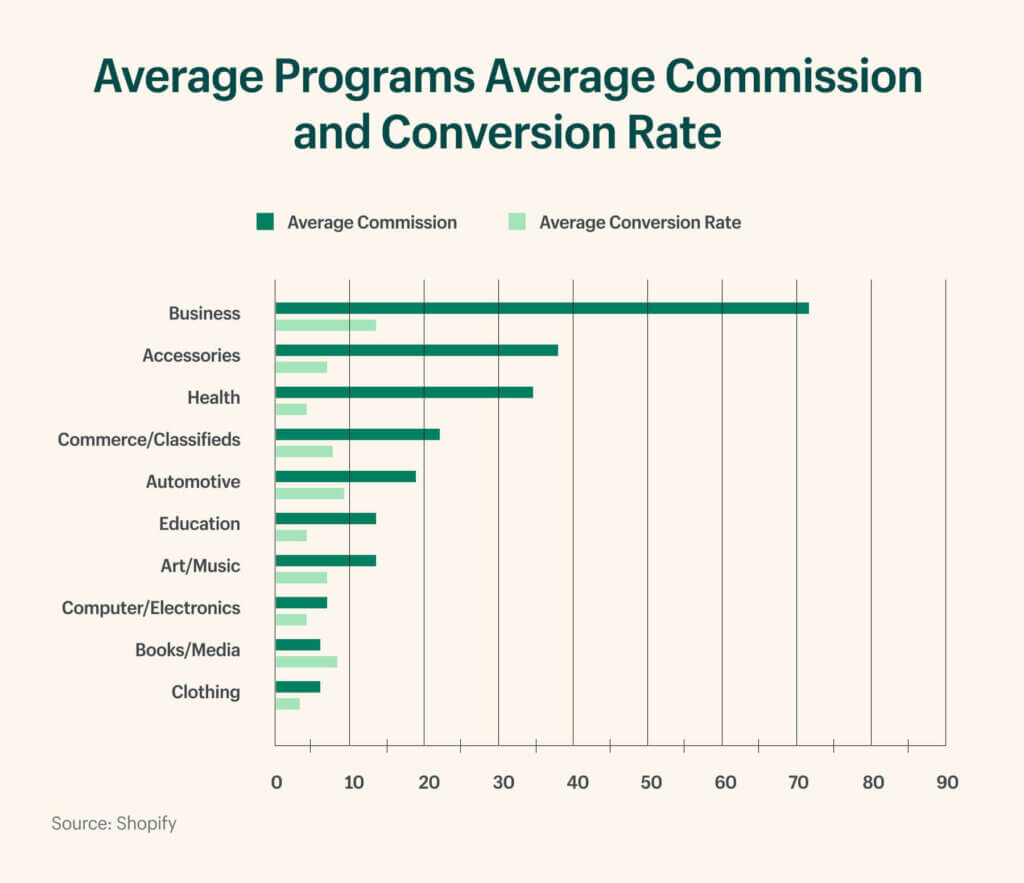Affiliate marketing has become a popular strategy for e-commerce businesses to drive sales and increase revenue. With the growth of online shopping, affiliate marketing has become an integral part of the e-commerce industry.
Affiliate marketing allows businesses to partner with influencers, bloggers, and other affiliates to promote their products or services. In return, affiliates receive a commission for every sale made through their unique affiliate link.

In this article, we’ll explore the benefits of affiliate marketing for e-commerce businesses, and how it can help businesses reach new audiences and increase sales. We’ll also provide tips and strategies for creating a successful affiliate program and partnering with the right affiliates.
Whether you’re just starting out in e-commerce or looking to expand your reach, affiliate marketing can be a valuable tool for growing your business. So let’s dive in!
Importance of affiliate marketing for e-commerce businesses
Affiliate marketing has become a crucial aspect of e-commerce. In fact, it is one of the fastest-growing segments of digital marketing. According to a study by Statista, the affiliate marketing spend in the US alone is expected to reach $8.2 billion by 2022.
This is because affiliate marketing can be a cost-effective way for e-commerce businesses to generate more sales and revenue. Through affiliate marketing, e-commerce businesses can partner with other websites or influencers to promote their products and earn a commission on every sale.
This means that e-commerce businesses can tap into a wider audience and benefit from increased brand exposure and trust, all while only paying for successful conversions.
How Affiliate Marketing Works
Affiliate marketing is a performance-based marketing strategy in which businesses pay affiliates a commission for each sale made through their unique affiliate link. The process of affiliate marketing involves the following steps:
- The e-commerce business creates an affiliate program and sets a commission rate for affiliates.
- Affiliates sign up for the program and receive a unique affiliate link or coupon code to share with their audience.
- Affiliates promote the business’s products or services through their channels, such as blog posts, social media, or email newsletters, using their affiliate link or coupon code.
- When a customer clicks on an affiliate’s link or uses their coupon code to make a purchase, the affiliate earns a commission on the sale.
- The e-commerce business tracks the sales made through each affiliate’s unique link or code and pays out commissions to affiliates on a regular basis.
There are different types of affiliates in affiliate marketing, including bloggers, influencers, content creators, and coupon sites.
Each type of affiliate has a different audience and promotion strategy, which can help e-commerce businesses reach a wider customer base and drive more sales.
Advantages of using Affiliate Marketing in E-Commerce
- Cost-effective: E-commerce businesses only pay commissions to affiliates when a sale is made, making it a cost-effective marketing strategy compared to traditional advertising methods.
- Increased reach: By partnering with affiliates, e-commerce businesses can reach new audiences and target niche markets they may not have been able to reach through their marketing efforts.
- Boost in sales: Affiliates promote products or services to their audiences who are already interested in the niche, resulting in a higher likelihood of conversions and sales.
- Improved SEO: Affiliate marketing can also improve the search engine rankings of an ecommerce business by generating backlinks and increasing brand exposure.
Setting Up an Affiliate Marketing Program
Affiliate marketing can be a powerful tool for e-commerce businesses to drive sales and increase their online presence. Setting up an effective affiliate marketing program can seem overwhelming, but breaking it down into three main steps can simplify the process.
- Choosing an affiliate network or building an in-house program: The first step in setting up an affiliate marketing program is deciding whether to use an existing affiliate network or to build an in-house program. Affiliate networks provide a platform for businesses to connect with potential affiliates and track sales, but they typically charge fees and commissions. Building an in-house program can give businesses more control over their program and potentially save money, but it requires more resources and effort to set up and manage.
- Determining commission rates and cookie durations: Once a business has decided on an affiliate program model, the next step is to determine commission rates and cookie durations. Commission rates typically range from 5% to 30%, and cookie durations can vary from a few days to several months. It’s important to strike a balance between offering competitive rates and ensuring profitability.
- Creating promotional materials for affiliates: The final step in setting up an affiliate marketing program is creating promotional materials for affiliates to use. This can include banners, text links, product images, and coupon codes. Providing a variety of materials can help affiliates promote products more effectively and reach a wider audience.
By following these three steps, businesses can set up a successful affiliate marketing program that drives sales and grows their online presence.
Tools to Set up an Affiliate Marketing Program for E-Commerce Websites like Shopify
There are several tools available to set up an affiliate marketing program for an e-commerce website. Here are some of the best options especially if you’re a Shopify store owner.
- Refersion: This app offers a comprehensive affiliate tracking system that allows businesses to track referrals, commissions, and payments. It also provides tools for managing affiliates and creating promotional materials.
- LeadDyno: It offers features like automatic affiliate sign-up, an affiliate dashboard, and real-time reporting. It also integrates with popular email marketing services like Mailchimp and Constant Contact.
- Affiliate Royale: This app provides businesses with the ability to create custom affiliate programs, set up commission rates, and manage affiliates. It also integrates with popular e-commerce platforms like WooCommerce and Easy Digital Downloads.
- OSI Affiliate Software: OSI Affiliate Software offers a range of features like an affiliate dashboard, real-time reporting, and automatic affiliate sign-up. It also provides tools for creating custom landing pages and promotional materials.
- Secomapp Affiliate Marketing: This app is designed specifically for Shopify stores and offers features like an affiliate dashboard, real-time reporting, and automatic affiliate sign-up. It also provides tools for creating custom banners and promotional materials.
These are just a few examples of the many apps available for setting up an affiliate marketing program. It’s important to research and compare different options to find the best fit for your business.
Finding and Recruiting Affiliates
Now that you have set up your affiliate marketing program, the next step is to find and recruit affiliates who can help promote your products or services. However, finding the right affiliates can be a daunting task, especially if you are new to the world of affiliate marketing.
In this section, we will explore some strategies for researching and contacting potential affiliates, as well as providing incentives for them to join your program. With the right affiliates on board, you can increase your reach and drive more sales for your e-commerce business.
Researching potential affiliates
It is an essential step in finding the right affiliates for your program. It involves identifying individuals or companies that have a relevant audience and align with your brand values. One way to research potential affiliates is to use an affiliate network or directory, which provides a list of affiliates and their respective audiences.
Another way to research potential affiliates is to use search engines and social media platforms to identify relevant bloggers, influencers, or other potential affiliates who are already promoting products similar to yours. You can also use tools like Google Analytics to identify websites that are driving traffic to your site, as these may be good candidates for your affiliate program.
When researching potential affiliates, it’s important to consider the quality of their audience and engagement rates. High traffic doesn’t always equate to high-quality traffic, so it’s essential to assess the relevance and engagement of the potential affiliates’ audiences.
You can also look at the potential affiliates’ past collaborations with other brands and their performance metrics to gauge their effectiveness as affiliates.
Overall, researching potential affiliates is crucial in ensuring that you find affiliates who will effectively promote your brand and products to their audiences, leading to increased sales and revenue for your e-commerce business.
Contacting potential affiliates
When it comes to contacting potential affiliates, it’s important to keep in mind that they likely receive numerous emails and messages from businesses looking for partnerships. In order to stand out, it’s important to personalize your outreach and make it clear why your affiliate program is a good fit for them.
One effective way to do this is by highlighting the potential benefits and incentives that come with joining your program, such as competitive commission rates and the opportunity to promote high-quality products or services to their audience.
Additionally, it’s important to establish a relationship and build trust with potential affiliates by being responsive and providing them with any information or support they may need to effectively promote your products.
It’s also worth considering reaching out to affiliates through multiple channels, such as social media or networking events, in order to increase the chances of getting a response and building a lasting partnership.
Ultimately, the key to successfully contacting potential affiliates is to approach them in a thoughtful and personalized way that highlights the mutual benefits of working together.
Providing incentives for joining the program
Providing incentives for joining your affiliate program is a key factor in attracting potential affiliates. Some popular incentives include:
- Commission rates: Offering competitive commission rates is a great way to attract affiliates. If your commission rates are higher than your competitors, affiliates are more likely to promote your products.
- Exclusive offers: Provide affiliates with exclusive discount codes, free shipping, or other special offers to promote to their audience.
- Performance bonuses: Consider offering performance bonuses to affiliates who exceed a certain number of sales or reach a particular revenue target.
- Affiliate contests: Organize contests for affiliates with attractive prizes such as cash bonuses, trips, or other rewards. This encourages affiliates to work harder to promote your products.
- Personalized support: Provide dedicated support to your affiliates, including personalized recommendations on how to optimize their marketing strategies, promotional materials, and fast response times to their inquiries.
By providing a variety of incentives, you can increase the attractiveness of your affiliate program and attract more quality affiliates who will be motivated to promote your products and generate sales.
ALSO READ: The 4 Stages Of Word Of Mouth Marketing
Types of affiliates
There are different types of affiliates that e-commerce businesses can work with to promote their products or services. Some of the most common types of affiliates include:
- Bloggers: These are individuals or businesses that run blogs or websites that focus on a particular niche or topic. They can be a powerful force for promoting products and services through sponsored content, reviews, or product placement.
- Influencers: Influencers are individuals with a significant social media following and have the ability to influence the purchasing decisions of their followers. They can be found on various social media platforms like Instagram, YouTube, or TikTok.
- Coupon sites: These affiliates specialize in providing discount codes, coupons, and deals to their audience. They are popular among consumers who are always on the lookout for ways to save money.
- Comparison sites: Comparison sites allow customers to compare prices, features, and benefits of products from different brands. They help consumers make informed decisions by presenting information in an easy-to-read format.
- Loyalty and cashback sites: These affiliates provide incentives to customers for making purchases through their links. They offer loyalty points, cashback, or other rewards that customers can redeem for future purchases.
Looking to take your influencer marketing to the next level? Our expert team in Mapplinks has years of experience in creating successful influencer marketing campaigns for a wide range of businesses. We work with a variety of influencers, from micro-influencers to industry leaders, to help you get the best results possible.
Here’s a case study involved a Fitness Protein Rine Bar that was struggling to generate buzz on social media.
We worked with a network of relevant influencers to create a series of posts and stories promoting the brand’s products.

The result? A significant increase in engagement, reach, and ultimately sales.
Whether you’re just starting out with influencer marketing or looking to optimize your current campaigns, Mapplinks is here to help. Contact us today to learn more about our ecommerce marketing services and how we can help take your business to the next level.




